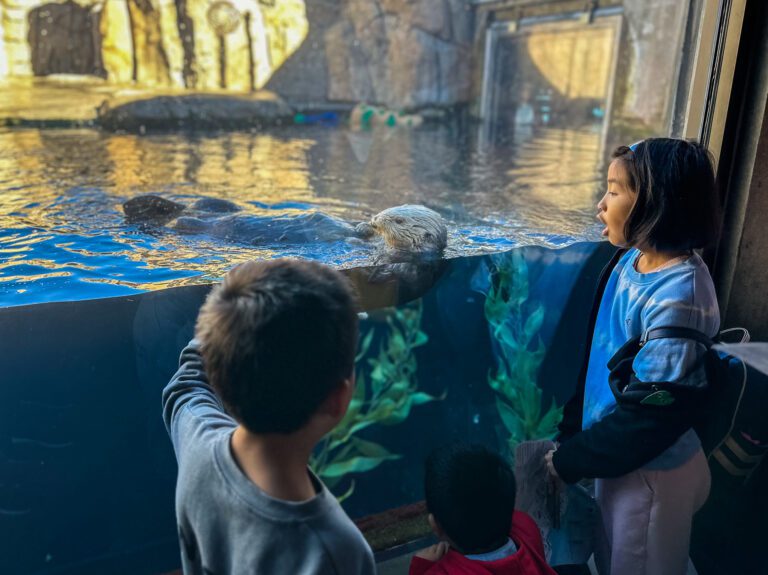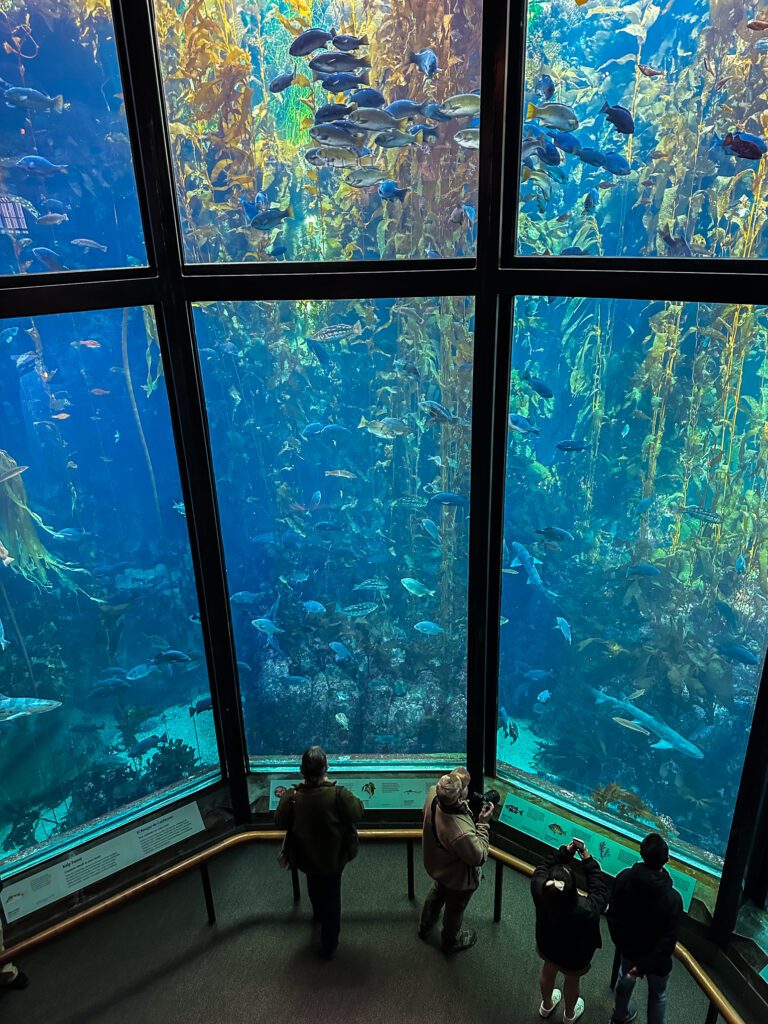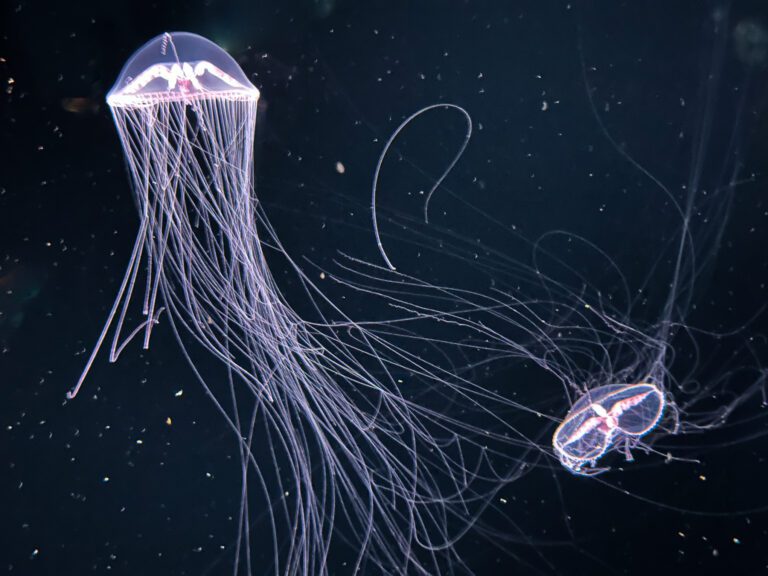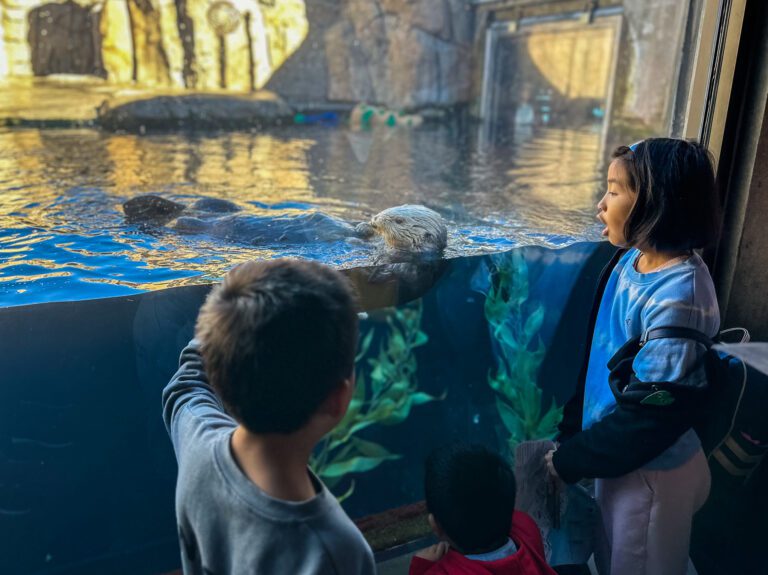Sardines circle in a never-ending silver stream above the entrance to the Open Sea exhibit at the Monterey Bay Aquarium. The spectacle beneath the swirling center of a school of sardines is so entrancing that some aquarium visitors are said to lie on their backs on the floor to fully experience it.
Since it opened in 1984, the Monterey Bay Aquarium has created many such awe-inspiring scenes. It was the world’s first aquarium to devote itself to telling the story of its home waters and has done so to great acclaim.
It was, however, the aquarium’s work protecting Monterey Bay and restoring Monterey’s historic Cannery Row, its leadership in ocean conservation and education, and the compelling visual beauty, breathtaking scale and innovations of its exhibits that resulted in it recently being presented the Society of American Travel Writers prestigious Phoenix Award for cultural, historical, and environmental preservation.
Monterey Bay Aquarium is perched beside the opalescent-blue waters of Monterey Bay, not far from where Spanish explorer Sebastián Vizcaíno first landed in 1602. The aquarium’s Executive Director Julie Packard often says, “the biggest and best exhibit at Monterey Bay Aquarium is the Bay itself. You go out on the back decks and see humpback whales breaching or sea lions, harbor seals, sea otters and sea birds going by. It’s definitely the place where people connect with the real Bay and feel that deep connection to the ocean.”
Its proximity to California’s central coast and the Monterey Peninsula – as well as its own qualities – has made the Monterey Bay Aquarium one of California’s not-to-be-missed destinations.
Cannery Row was not an attraction when John Steinbeck wrote his novel of the same name in 1945. The book was set in Depression-era Monterey when the canneries along the row were bustling with activity, an olfactory stew of offensive fish and industrial odors, and operating with such ruthless efficiency that they’d depleted the bay of millions of sardines by the early 1950s.
Twenty years later the last of the canneries had collapsed. Their abandoned industrial structures began being occupied by souvenir shops and restaurants, but Cannery Row was still just a literary footnote. Storybook-like Carmel, posh Pebble Beach, idyllic Carmel Valley, scenic Big Sur and historic Monterey were the area’s prime reasons for visiting.
At the time, the Packard family was searching for “a big project that would really make a difference.” David Packard funded his family’s foundation with the fortune he’d accumulated from the sale of Hewlett-Packard, the Palo Alto, Calif. electronics firm he’d founded in 1939.
Previously, the 1969 Santa Barbara oil spill – then the largest in U.S. history – had raised the Packards’ concern about the fragility of ocean environments. Julie Packard later wrote that the loss of thousands of sea birds and countless other ocean animals in that spill made growing environmental activism and unrest, “all too real.”
Sitting beside Stanford’s Hopkins Marine Station at the west end of Cannery Row was the then-empty Hovden Cannery, once the largest sardine cannery in Monterey. Two of Hopkins’ marine scientists were friends of one of the Packard sisters and mused wouldn’t it be great if the old cannery might be used to showcase the beauty of the bay’s marine life.
Thereafter, the Packards realized this might be “the” project that could make a difference. So, the Packard Foundation underwrote a feasibility study to determine whether a $55 million aquarium would “pencil out,” leading to purchase of the Hovden Cannery and retention of San Francisco architect Chuck Davis to redesign the 320,000-square-foot industrial plant.
Then retired, David Packard immersed himself in planning the aquarium, even going so far as to personally cast the bronze bollards outside the entrance to the aquarium in a hobbyist foundry on his Big Sur ranch. The resulting building reflects the cannery’s original lines, retains the cannery’s massive boilers (displayed prominently within its foyer) and features exposed wood truss ceilings, plumbing and mechanical systems, giving it the look and feel of a sardine cannery but repurposed to house more than 35,000 plants and animals. Yet, true to its industrial past, each day at noon the aquarium sounds a steam whistle heard across Cannery Row and beyond.
Vice President David Rosenberg says, “One aspect that makes the aquarium unique is that it brings 2,000 gallons of fresh saltwater per minute from the Bay into the exhibits, starting in the kelp forest and circulating throughout the aquarium, returning to the Bay just as clean if not cleaner. So, what you’re seeing is exactly what you would see if you could go out there.”
The signature element of the aquarium is its Kelp Forest. The exhibit takes visitors beneath the bay to see what life there is like at full scale. Lit by daylight from above, the kelp grows at a rate faster than tropical bamboo. They thrive in a towering, three-story-tall tank inhabited by a community of sea bass, sardines, anchovies, shark, rockfish and kelpfish … just as you’d find in the bay. Visitors sit awed by the spectacle.
The aquarium’s genius is to transform aquaria from halls of fish tanks into immersive aquatic environments, tanks that project out from the wall or large acrylic bubbles that allow visitors to lean into the tank as if they are surrounded by water.
During development of the aquarium, David Packard cautioned his team of marine scientists to control their enthusiasm, “We want this to be engaging and yeah, you guys might want to teach them (aquarium visitors) every last thing you learned in college, but this needs to be something that is entertaining.” Whether it is 600 gallons of surf that crashes every 30 seconds over and around you as you walk (bone dry) through the simulated rocky shores of Monterey Bay or a spawn of spiny, purple Sea Urchins, Monterey Bay Aquarium entertains while informing.
The colorful creatures of California’s tide pools (written about by pioneering Monterey marine biologist Ed Ricketts who inspired Steinbeck’s Cannery Row character, Doc): giant green anemones, acorn barnacles, pink-tipped aggregating anemones and deathly-green dead man’s fingers are all displayed and interpreted for easy viewing and understanding.
Inside the two-story Sea Otter exhibit, furry-faced sea otters delight visitors during daily feeding and training sessions. The symbol of the aquarium is a wreath of kelp, but its personality is embodied within the endearing face and antics of the sea otters, all of which are rescued females who also serve as surrogate moms for orphaned sea otter pups, later released to the wild.
Otters are the only marine mammals at the aquarium, though they are not its only stars. In the Open Sea exhibit, green sea turtles float gracefully through its 1.2 million-gallon tank as yellow fin tuna zip past. Hammerhead sharks, an ocean sunfish, dolphinfish and thousands of Pacific sardines swirl behind the tank’s 90-foot-long by two-story-tall picture window, one so massive and clear that during off-hours a curtain of bubbles prevents the fish from smashing into it.
Immense tanks are impressive, but it is the tiniest of sea creatures that set the Monterey Bay Aquarium apart. We… “put jellies on the map,” says Julie Packard. The aquarium perfected how to house, culture, care for and display these fragile beauties. Purple-striped jellies, orange-brown sea nettles, iridescent comb jellies and transparent moon and crystal jellies perform endless ballets before cobalt blue backgrounds. Monterey Bay Aquarium revealed nature as mesmerizing art.
The aquarium has now bested the Open Sea by going Into the Deep (its current special exhibit), sending deep submersible research vessels down to the sea floor to see what lives more than a mile below the surface.
Senior Content Specialist Ken Peterson explains, “David Packard participated in early research dives, realizing that: the open ocean is the last great frontier on our plant, that it is under explored, critically important to our survival, and that it could be explored more easily when scientists and engineers are brought together, as he did at HP. ‘Tackle something big and change the world’ was Packard’s guiding principal which led him to create the Monterey Bay Aquarium Research Institute.”
On dives, the Monterey Bay Aquarium team brings back startling wonders from the deep: scarlet bioluminescent Bloody-Belly Comb Jellies, immense Japanese spider crabs, prickly porcupine crabs, lacy bubblegum coral, shortspine thornyheads, North Pacific bigeye octopus, bone-eating worms and numerous varieties of jellies.
Each reveals the dazzling life forms that dwell within the black depths of Monterey Canyon, an ocean trench that’s invisible from the surface but angles out to sea through the center of Monterey Bay.
Astounding visitors with the wonders and mysteries of Monterey Bay has included exhibiting giant Pacific octopus that use special pigment cells in their skin to blend in with intricately patterned corals, plants and rocks, majestic bat rays which soar through the water and such pedestrian, inactive creatures as sand dollars.
Monterey Bay Aquarium was the first aquarium outside of Japan to exhibit tuna and the first on Earth to successfully exhibit juvenile great white sharks, before returning them to the wild.
Guiding visitor experiences are a front-line staff and eight hundred volunteers. Rosenberg said that while visitors come to see the exhibits, their most lasting impressions are often of the interactions they have with the aquarium’s guides.
Volunteers progress through stages. Red-jacketed volunteers – the most experienced – spend over 40 hours in training, and that’s atop the daily briefings they participate in before each shift. “We get really excited when the passion they have for the stories we tell rubs off on people,” Rosenberg says.
Education is a fundamental purpose of the institution, which set a record in its first year, becoming the first aquarium to top 2.4 million visitors. Over 71 million have passed through its doors since it opened in October 1984 and more than 2.7 million school kids have been able to visit the aquarium for free.
Online courses, developed during the pandemic, have taught students in every state and many countries, and Monterey Bay Aquarium’s $42-million, concrete, steel and glass Bechtel Family Center for Ocean Education and Leadership, established in 2019 on Cannery Row, inspires the next wave of ocean leaders: teachers and teens.
Julie Packard would be the first to tell you that the aquarium has learned from its visitors, as well. An early exhibit on unsustainable fishing and aquaculture inspired visitors to ask how they could make more informed choices when buying seafood. Those comments led Monterey Bay Aquarium to start Seafood Watch, a consumer guide to purchasing sustainable seafood in restaurants and markets. It grew from a pocket guide (still given to aquarium visitors) to a cell phone app, to a global program that has stimulated significant improvements in how seafood is harvested and grown.
Other initiatives helped recover threatened populations of sea otters along the California coastline, establish the Monterey Bay National Marine Sanctuary, improve marine research and educate policy makers to the threats to the ocean environment from micro plastics. Each of these is explored in depth and entertainingly within the aquarium.
Plan to spend at least four hours at the aquarium. Shows and feedings will extend your stay. Admission is $59.95 for adults, $49.95 for teens (13 – 17), $44.95 for children (5 – 12) and $49.95 for seniors (70+), with members able to enjoy unlimited visits during the year. Open 10 – 5 daily, except Dec. 25. Parking is $20 at nearby city lots.
You can dine inside the aquarium at its cafe (salads, sustainable seafood, sandwiches and burgers, fish tacos and burritos) or exit (with hand stamp) to dine at any number of casual to fine restaurants a short walk along Cannery Row. Lodging varies from campsites, to inexpensive yet nicely kept chain motels in nearby Seaside, to luxurious lodges and inns on the Monterey Peninsula.
The aquarium is busiest from late spring through early autumn. Weather is best in winter between storms. It’s often foggy and cool on summer days. A 2-hour, guided Cannery Row Kayak Tour (from $65) complements a visit to the aquarium by getting you paddling on the bay while seeing sea lions, harbor seals, seabirds and sea otters, as well as waterside views of the aquarium.
Allow one or two additional days to explore Monterey (California’s first capital) with its many examples of late 1700s Monterey adobes (an architectural style specific to Monterey), the 17 Mile Drive and its famous golf courses and seascapes, the artist’s community of Carmel and Mission Carmel (the most beautiful of California’s Spanish colonial mission churches), and the seascapes and cypress and redwood forests of Point Lobos and Big Sur.
On the aquarium’s opening day, Julie’s mother, Lucile, summed up what many visitors experience, saying, “In all my life I’ve never been able to see what’s under the water. Now I can. Now everyone can.”





